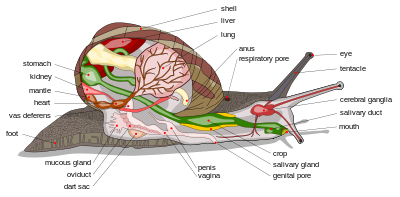
Reproduction
All pulmonate
snails are hermaphroditic and have both male and female
reproductive organs, but they still mate with other individuals
when they can, but they are capable of self-fertilization (Scholarpedia.org).
Snails will go through simultaneous reproduction when
they do find a mate. Each individual will act as the female and
the male during reproduction and both will acquire sperm from
the other for fertilization (Scholarpedia.org).
The ovitestis is
the organ that produces both sperm and eggs, which are released
through the hermaphroditic duct. (Thorp,
2010).
The Albumen gland
is responsible for distributing nutrients and protein to the eggs
before fertilization (Thorp, 2010).
The fertilized
eggs of terrestrial snails are usually laid in a soft, moist place
that will be protected from predators (Thorp,
2010).
The number of
eggs laid varies from species to species, as does the number of
times a year fertilization occurs (Scholarpedia.org).
